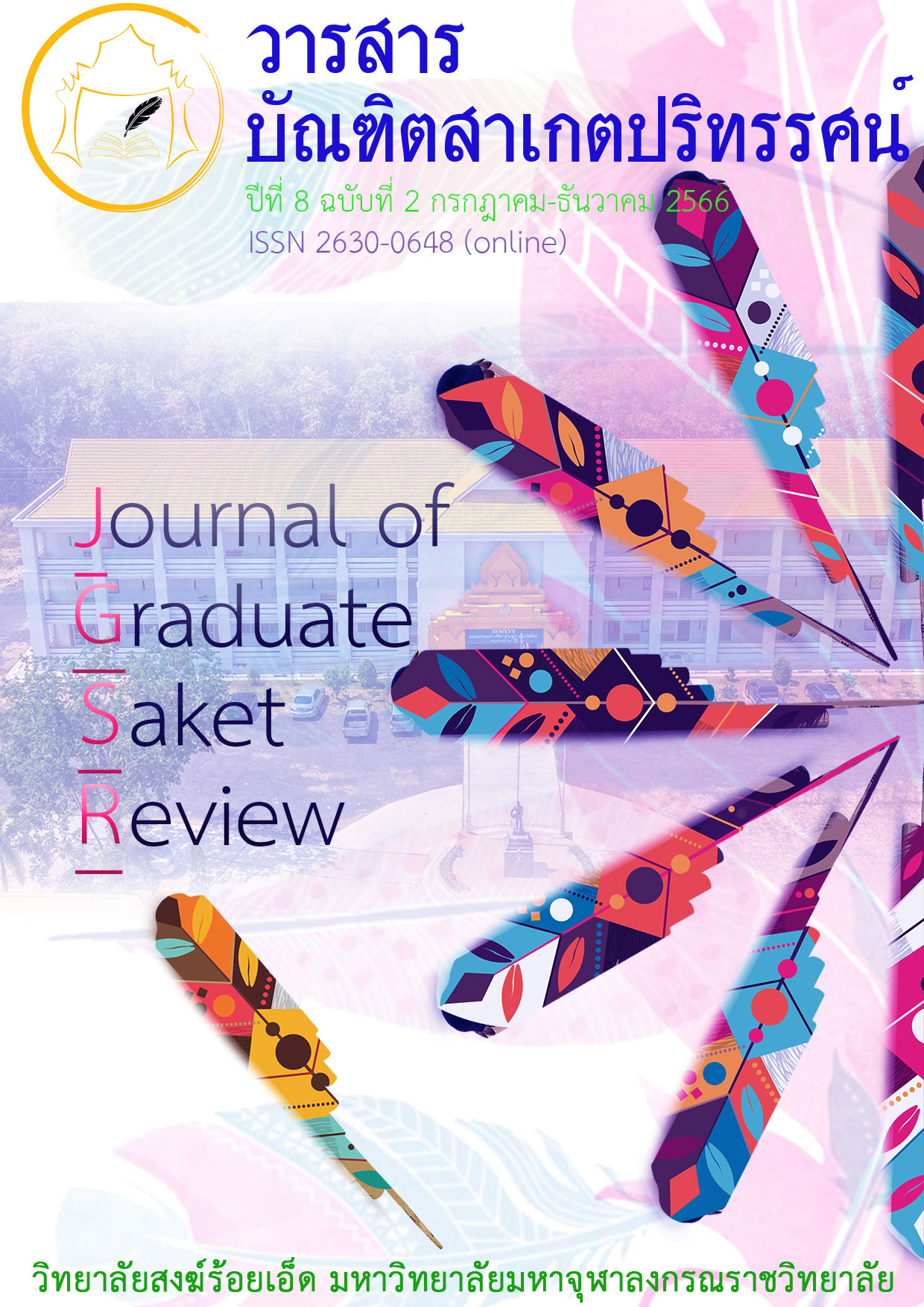การวิเคราะห์การเผยแผ่ธรรมะในยุคดิจิทัลตามหลักประโยชน์นิยมในทางจริยศาสตร์
Main Article Content
บทคัดย่อ
บทความวิจัยนี้มีวัตถุประสงค์ (1) เพื่อศึกษาการเผยแผ่ธรรมะในสมัยพุทธกาลและปัจจุบัน 2) เพื่อศึกษาสภาพการเผยแผ่ธรรมะในยุคดิจิทัลและหลักประโยชน์นิยมทางจริยศาสตร์ 3) เพื่อวิเคราะห์การเผยแผ่ธรรมะในยุคดิจิทัลตามหลักประโยชน์นิยมทางจริยศาสตร์ การวิจัยครั้งนี้เป็นการวิจัยเชิงคุณภาพโดยศึกษาจากคัมภีร์พระไตรปิฎก เอกสารทางวิชาการ และ งานวิจัยที่เกี่ยวข้อง โดยใช้หลักการวิเคราะห์ข้อมูล แล้วนำเสนอผลการวิจัยด้วยวิธีการวิเคราะห์เชิงพรรณนา
ผลการวิจัยพบว่า
การเผยแผ่ธรรมะในครั้งพุทธกาลใช้วิธี “มุขปาฐะ” เป็นสำคัญ โดยมุ่งเน้นไปที่การเผยแผ่นั้นเป็นไปเพื่อประโยชน์แก่ชาวโลก
การเผยแผ่ธรรมะในยุคดิจิทัล พระนักเผยแผ่ยังติดอยู่กับการเผยแผ่แบบดั้งเดิม พระสงฆ์ยุคดิจิทัลต้องเรียนรู้ มีการ รับข่าวสารที่เป็นข้อมูลไม่จริง มีการตัดสินข้อมูลหรือข่าวที่ได้รับว่าผิดหรือถูก เห็นด้วยหรือไม่เห็นด้วยกับข้อมูลที่ได้รับในทันที มีการเสพข่าวสารอย่างขาดสติ และมีจิตใจไม่หนักแน่นต่อการเผยแผ่ได้ตลอด ชีวิตของพระผู้เป็นนักเผยแผ่
เมื่อนำหลักประโยชน์นิยมมาวิเคราะห์ พระนักเผยแผ่จะต้องมองเห็นหรือตระหนักรู้ถึงประโยชน์เกื้อกูลและความสุขของชาวพุทธส่วนใหญ่ เพราะชาวพุทธต้องการพระนักเผยแผ่ที่มีความรู้และมีความประพฤติดีงาม เพื่อช่วยชี้ช่องบอกทางดำเนินชีวิตที่ถูกต้องตามครองธรรมให้อยู่เสมอ ดังนั้น พระนักเผยแผ่จึงต้องเป็นผู้มองเห็นประโยชน์ของคนส่วนใหญ่เป็นที่ตั้ง เพราะการกระทำของพระนักเผยแผ่ธรรมะตามที่กล่าวมาเป็นสิ่งที่ถูกต้องสมบูรณ์ คือ เป็นการสร้างความสุขให้กับคน
หมู่มากตามหลักประโยชน์นิยมในทางจริยศาสตร์
Article Details

อนุญาตภายใต้เงื่อนไข Creative Commons Attribution-NonCommercial-NoDerivatives 4.0 International License.
เนื้อหาและข้อมูลในบทความที่ลงตีพิมพ์ในวารสารบัณฑิตสาเกตปริทรรศน์ ถือเป็นข้อคิดเห็นและความรับผิดชอบของผู้เขียนบทความโดยตรงซึ่งกองบรรณาธิการวารสาร ไม่จำเป็นต้องเห็นด้วย หรือร่วมรับผิดชอบใด ๆบทความ ข้อมูล เนื้อหา รูปภาพ ฯลฯ ที่ได้รับการตีพิมพ์ในวารสารบัณฑิตสาเกตปริทรรศน์ ถือเป็นลิขสิทธิ์ของวารสารบัณฑิตสาเกตปริทรรศน์ หากบุคคลหรือหน่วยงานใดต้องการนำทั้งหมดหรือส่วนหนึ่งส่วนใดไปเผยแพร่ต่อหรือเพื่อกระทำการใด ๆ จะต้องได้รับอนุญาตเป็นลายลักอักษรจากวารสารบัณฑิตสาเกตปริทรรศน์ ก่อนเท่านั้น
เอกสารอ้างอิง
มหาวิทยาลัยมหาจุฬาลงกรณราชวิทยาลัย. (2539). พระไตรปิฎกภาษาไทย ฉบับมหาวิทยาลัยมหาจุฬาลงกรณราชวิทยาลัย. กรุงเทพมหานคร: มหาวิทยาลัยมหาจุฬาลงกรณราชวิทยาลัย.
นนท์ ธรรมสถิต. (2532). พระพุทธศาสนาและคณะสงฆ์ไทย (เล่ม 1). กรุงเทพมหานคร: สำนักพิมพ์กิตติชัยสาส์น.
พระสมชาย ฐานวุฑฺโฒ. (2543). มงคลชีวิตก้าวหน้า. กรุงเทพมหานคร: บริษัท ฐานการธุรกิจ จำกัด.
พระพิษณุ วฑฺฒนธมฺโม (พุทธวัฒนานนท์). (2558). รูปแบบและกระบวนการเผยแพร่ธรรมของ ว.วชิรเมธี (พระมหาวุฒิชัย). วิทยานิพนธ์พุทธศาสตรมหาบัณฑิต. บัณฑิตวิทยาลัย: มหาวิทยาลัยมหาจุฬาลงกรณราชวิทยาลัย, 2558.
สุภารักษ์ จูตระกูล. (2556). การใช้โซเซียลมีเดียในการเผยแผ่พุทธศาสนาเชิงรุกของพระสงฆ์. วิทยานิพนธ์นิเทศศาสตร์มหาบัณฑิต. คณะนิเทศศาสตร์: มหาวิยาลัยนอร์ทกรุงเทพ.
ช่อฟ้า เกตุเรืองโรจน์ และรองศาสตราจารย์ อวยพร พาณิช. (2554). กระบวนการและกลวิธีการสื่อสารเพื่อถ่ายทอดพุทธธรรมในหนังสือธรรมะของท่าน ว.วชิรเมธี. วารสารวิจัยและพัฒนา. 3, 78-91.
พระเลิศพิพัฒน์ จนฺทปญฺโญ (แก้ววันทอง). (2554). บทบาทของพระสงฆ์ในสังคมยุคโลกาภิวัตน์. วารสารการศึกษาและพัฒนาสังคม. 7(2), 6-16.
พระมหาธนิต สิริวฒฺฑโน. (2558). รูปแบบและกระบวนการสื่อสารพุทธธรรม. วารสารวิจัยราชภัฏเชียงใหม่. 16(2), 75-86.
พระครูวินัยธรปัญญา ปญฺญาวโร (ศรีสมุทร). (2564). การจัดการเผยแผ่พระพุทธศาสนายุคดิจิทัล. วารสารสังคมศาสตร์และมานุษยวิทยา. 6(4), 423-433.
พระเทพดิลก (ระแบบ ฐิตญาโณ). (2548). ที่นี่คือ...ประเทศไทย. กรุงเทพมหานคร: พรศิวการพิมพ์.
ภาณุพงศ ไทรใหญ. (2563). พระพุทธศาสนาในสมัยกรุงรัตนโกสินทร. วารสารปรัชญาปริทรรศน์. 25(1), 68-79.
Mahachulalongkornrajavidyalaya University. (1996). Thai Tripitaka. Mahachulalongkorn rajavidyalaya University edition. Bangkok: Mahachulalongkornrajavidyalaya University.
Thamsathit N.. (1989). Buddhism and the Thai Sangha (Volume 1). Bangkok: Kittichaisan Publishing House.
Phra Somchai Thanawuttho. (2000). Mongkol Life Progress. Bangkok: Thanthurakit Company Limited.
Phra Phitsanu Vaddhanadhammo (Phuttawattananon). (2015). Form and process of disseminating the Dhamma of V. Vajiramedhi (Phra Maha Wuttichai). Master of Buddhist Studies Thesis Graduate School Mahachulalongkornrajavidya laya University, 2015.
Chutrakul S.. (2013). The use of social media in the proactive propagation of Buddhism by monks. Master of Communication Arts thesis. Faculty of Communication Arts North Bangkok University.
Ketruangroj C. and Panich P.. (2011). Communication processes and strategies for Conveying Buddhism in the Dhamma book of V. Vajiramedhi. Research and Development Journal. 3, 78-91.
Phra Lertpipat Chantapanyo (Kaewwanthong). (2011). The role of monks in a globalized society. Journal of Education and Social Development. 7(2), 6-16.
Phra Maha Thanit Siriwatthano. (2015). Forms and processes of communicating Buddhism. Chiang Mai Rajabhat Research Journal. 16(2), 75-86.
Phrakru Vinaithornpanya Pañavaro (Srisamut). (2021). Management of the propagation of Buddhism in the digital age. Journal of Social Sciences and Anthropology. 6(4), 423-433.
Phra Thepdilok (Rabaeb Thittayano). (2005). This is...Thailand. Bangkok: Phon Siwa Printing.
Saiyai P.. (2020). Buddhism in the Rattanakosin period. Journal of Philosophy Periscope. 25(1), 68-79.


